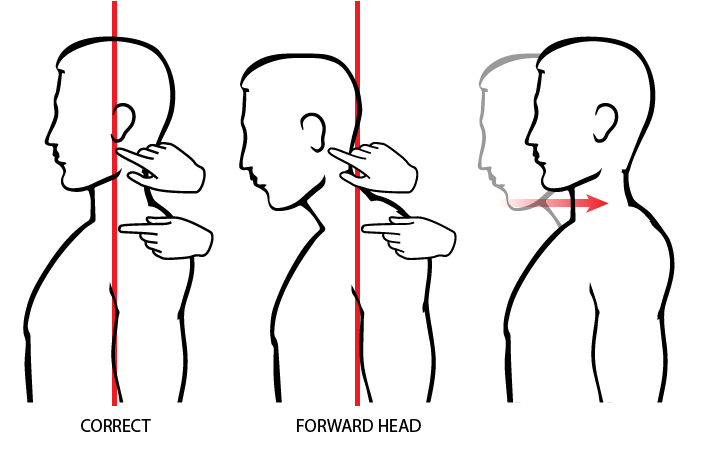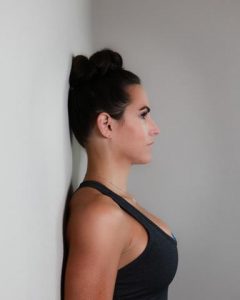Recently I coached a guy who wanted a general strength and conditioning program with an eye to returning to high jumping. He complained about pain around the neck, scapula and shoulders, and he told me all the exercises he blamed for causing or aggravating the pain. Then I asked the magic question: “If you weren’t training, would you still get some pain in the same areas?”
dom cadden
You can guess the answer. I had the advantage that I already knew his job involved a lot of time sitting and craning his neck at a computer monitor – but then, so many people do. We can’t all be professional athletes, so we work or study without, unfortunately, a masseur or physical therapist to massage us every day after a particularly long endurance session of sitting on our butts.
Tightening and shortening of the muscles around the neck and upper back make us a lot more vulnerable to further pain and injury when we train. This is not just something you get from strength training, either – I’ve seen it in running and cycling, too.
A recent journal article published through the American College of Sports Medicine (ACSM) laid out some exercises people can do in the workplace to relieve the build-up of tension and improve posture in order to reduce neck and upper back pain (which in turn is often causes headaches). You don’t need to put on yoga pants or any special workout clothes – the exercises are small and subtle enough to do at the office.
The damage
The ACSM article identified that office workers tend to lean forward or slouch down in the chair, which the authors described as a “partial immobilisation” that can cause low-back pain or neck pain because this static posture increases stress on the back, neck, shoulders, arms, and legs. Sitting can even put large amounts of pressure on the spinal discs and ligaments.

What’s more, studies have shown that people with neck pain have demonstrated proprioception disturbances, position sense abnormalities, balance deficits, and altered eye movement control. That might be no big deal for doing paperwork, but if you do any sport, some or all of those things are very bad news.
William J. Hanney, an instructor in the Physical Therapy program at the University of Central Florida, said that the ‘‘neck is a remarkable mobile joint that acts as a crossroad for the trunk, upper extremities, and head. Therefore, fluent movement and orientation of the head and neck are required to position senses to our surroundings.”
What this means that it takes more than the best ergonomic chair money can buy and a good sitting and monitor position to avoid neck pain, and the consequent upper back, shoulder and scapula pain that often follow. You need to get moving.
Neutral sitting position
The first thing to check is whether you can sit in a neutral position and still comfortably use your computer, phone, check your monitor, etc. The article points out that sitting in the neutral position described below is well established as the only way to control this excessive and prolonged muscle activity of the head’s deep flexors and correct the other issues associated with poor seating posture.
Find your neutral sitting position by rolling/tilting your pelvis forward to create a natural curve in your lumbar spine. Now lift your sternum up vertically – this action should lift and push out your chest a little, and your shoulders should fall back and down. Tuck your chin in and raise your head to a comfortable position – about 10-15° off vertical. Computer monitors should be adjusted so you see them well in this position. Hold this position as much as possible for static seated activities, e.g. typing, talking on the phone
Standing exercise
- Stand with your back to a wall. Flatten your lumbar spine (spine below ribs) against the wall by tilting your pelvis. Now bring your shoulder back so they are in contact with the wall – hold for 10 seconds. Tuck your chin in. Lift your head up while keeping chin tucked.
- From the position above, make slow, controlled movements to move the head and neck in all directions in a pain-free range of motion, i.e. head own, head up, rotate chin to right and left, tip head right and left as if trying to put ear against each shoulder.
- Cup the hands behind the neck while trying to press your elbows back to touch the wall. Stretch and extend the head upward and backward with the chin tucked down.
- Now stand away from the wall in a relaxed position, hands on thighs. Slowly roll your shoulders in large circles forwards, then backwards. Hold for 2-3 seconds at the end of each roll.
Seated exercise
- From the above position, make slow and controlled movements of the neck in all directions – down, up, turning to each side and tilting ear towards each shoulder. Follow each movement with your eyes, then repeat but with the eyes closed.
The authors recommended doing this 5-10 minute routine of standing and seated exercises every 2-3 hours of sitting.
Training
If you are susceptible to neck and upper back pain, here are some measures that you can take with your warm-ups and in your strength programs.
- Stand with a small weight in each hand with your shoulders relaxed and back. Slowly tilt your head so your ear goes towards your shoulder.
- In the same position and still holding small weights, rotate your shoulders inwards so the back of your hands are touching, then rotate hands 180 degrees so that back of hands end up besides hips and shoulder blades pull in tight together. Keep elbows tight to your body throughout the motion
- Replace some double-arm pressing motions with single-arm pressing. These require a longer range of motion for the trapezius muscles (if these are tight and/or have shortened range of motion, this can cause neck pain), more scapula movement, plus they are less likely to create less of a band of pressure across the base of the neck and between the shoulder blades
- Try an exercise which stretches the trapezius then forces the muscle into a rapid activation, e.g. a clean or single-arm snatch
- When doing exercises such as squats, lunges and deadlifts, hold the head in a more neutral position, pulling the chin in closer to your neck – that is, avoid craning your head and neck forward of your shoulders.
A version of this article was first written for the websites of 2XU North America and 2XU Australia.








